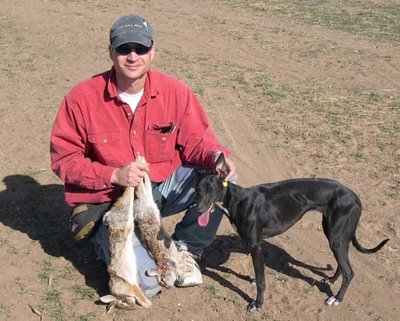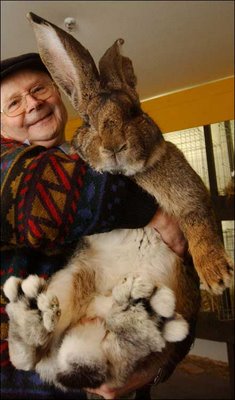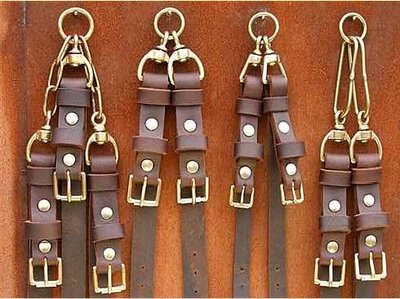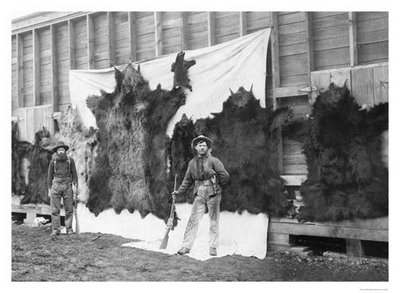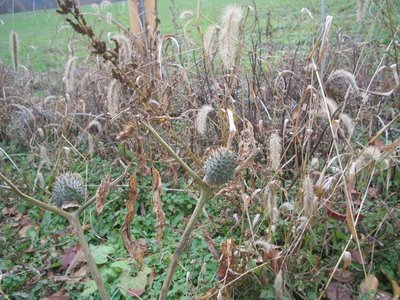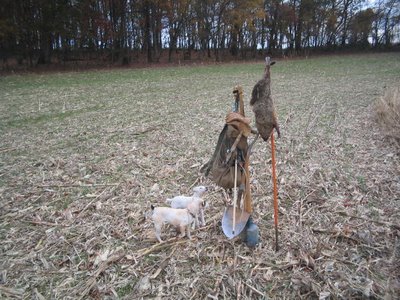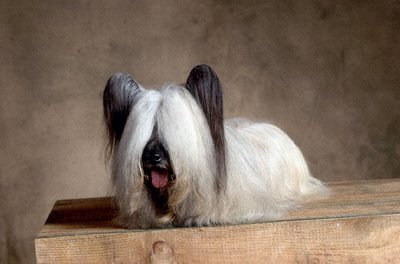 Chris peers into the hole.
Chris peers into the hole.
On the drive out to the farms this morning, the truck thermometer said it was 33 degrees out, and the first frost of the season was evident on the grass. The temperature would climb at least 20 degrees today -- maybe 25 -- but the groundhog season was over, as groundhog hibernation is driven by light, not by temperature. This is true for bird migrations too -- an unseasonal period of warm weather in the Fall does not fool the birds.
Beginning with Thanksgiving and continuing to Christmas -- a period of about a month -- it's hit or miss with quarry, with a very high liklihood of getting hit by skunk, and a better than-average chance of finding possum and raccoon. After Christmas, the raccoon and skunk are generally hibernating (the male raccoon will begin moving around again in early February as they beging looking for mates), and groundhogs will very occassionally exit to defecate and then trundle back down to sleep for a few more weeks. Possum are active all year long, though they will lay up for long periods of really cold weather. After Christmas until the first of March it's fox season, with the peak in late January and running through February.
Chris and I met at the Flint Hill store. I had in mind pulling into a new parking spot close to a creek bed we could walk looking for game, but as I drove by I noticed two SUVs parked right where I wanted to pull in.
Deer hunters. It turns out it's the first day of shotgun season.
Oh goodie. How many first days of the season are there? First day of early black powder, first day of shot gun, first day of rifle, first day of bow, first day of regular black powder ....
No worries -- off to another farm.I turned around, and Chris followed me back up the road, and we pulled into a nice big place that has a nice creek and a small bog on it. It was going to be a nice clear day -- not too cold or windy -- and I had high hopes.
Or should I say I had high hopes until I got out of the truck and walked 100 feet. The fields were soaked.
Where did all this water come from? I did not remember too much rain from the week before, but it had clearly come down very hard here just 25 minutes up the road.
We hunted the dogs up the hedge, busting out a fair sized doe and a black-and-white feral cat which managed to get away with its life. We crossed above a boggy area and hunted down the top of a field where there were quite a few holes in a more-or-less dry hedge row. A large new push-pile has been bulldozed up, but nothing was home.
We crossed down the field to a creek bottom and began walking up the high side of the creek. Mountain gave voice for a second, and the dogs and I followed into the hedge, but nothing could be found, and Mountain trotted up from behind us as if she had bolted something into the field. Whatever it was, it was lost now.
We continued down the hedgerow on the high bank above the creek. In the distance I could hear guns blasting away. There was a large metal tree stand -- the type large enough to hold four hunters and a propane grill -- overlooking this field. No one was in it, but I still found myself routinely looking up the hill to make sure I was not being scoped in on.
At the end of the hedge, we crossed over the creek and begn walking up the hill to another long hedge about 100 yards above the water, but Mountain was nowhere to be found. We waited a bit, and I whistled, but after another minute it was pretty clear Mountain had found.
I crossed back over the creek and began boxing some likely settes, but she was not in them. Chris crossed over too and walked up the hill towards the big deer stand but did not find anything. He then crossed back over the creek and began walking down the high hedge where we had been headed, while I continued to call and box a few more possible settes. Chris whistled and said he had found her -- he was walking down the field and pointing to the same hedge I was in, but about halfway back down the course we had just come up. He could hear herfrom up on top, but the acoustics were such that even though I was closer, I could hear nothing.
I gathered up my tools, and Chris did the same, and we headed over to see what Mountain had in the ground. I doubted it was a groundhog -- it would have dug away by now. Probably a possum, maybe a coon. Or a cat. Too warm for fox yet.
Mountain was on the other side of the creek, and we waded over to find her in the middle of a very old and thick multiflora rose jumble.
Time to break out the machetes.This sette had about five eyes, and a quick boxing showed Mountain about three feet down in a mess of old roots and brambles. We hacked away at the vegetation, and then worked with machete and saw on the thick roots twising along the ground. After we had it cleared it out pretty well, I reboxed to locate the dog, found Mountain to be exactly where she had been before, and we began to dig.
This was not a particularly hard dig, but we did pull out some big rocks -- one the size of my upper torso, and the other the size of a small turkey. At one point Mountain came out -- she had been underground working this critter for about an hour, and whatever it was could not go anywhere or dig away.
With Mountain out, Pearl slid in and bayed it up nicely -- a nice deep voice. Mountain, hearing Pearl give voice, turned back around and pushed her way back in down another hole. She winkled past Pearl somehow, and Pearl came out. Pearl's a very young and inexperienced dog yet, but I am very pleased with how readily she is entering and working. This is only her third dig.
Pearl had riled up the critter in the hole, and Mountain was winding it up a little more, and by now, from the sound in the pipe, I was pretty sure we had a raccoon.
At about two and a half feet down we hit dry dirt, and I was pretty sure the dog was only ahout 6 inches deeper. Chris scraped the loose dirt out of the hole, and I carefuly barred and broke through into the den only 6 or 7 inches below.
Excellent. Time for the posthole digger.
This last six inches was very dry and seemed to be made up of mostly degraded rock, but the posthole digger is a tough instrument, and it punched through in short order.
We pulled Mountain and tied up the dogs while we opened up the hole to see what we had. Chris dropped Moxie in hole, and she shot up the pipe and engaged -- there was small a roar in the hole and now I was sure it was either a coon or a very loud possum. Moxie has a habit of going for a head grab, but this time she was working in the dark, and I told Chris to let her work it a bit as I doubted she was going to be so brave and foolish wihtout light. After a while, we pulled Moxie, and she seemed to be no worse for the wear. A little dark tunnel work is all Moxie needs. She's a great little dog.
Chris went to tie Moxie up, and I looked in the hole to see the top of a raccoon head poking out. Hello!The raccoon took one look at my ugly face, turned around, and pushed in as deep as it could. I postholed the pipe a bit to cut away the overhang, and I could see the raccoon's tail now. After a brief pause to see if she would relax, turn around, and bolt out on her own, we brought Mountain back over, and she turned the raccoon in short order.
With the coon turned around, we pulled Mountain and I got a snare over the coon and pulled it tight. We had decided to take picture and let this one go, but as the cable tightened up the coon pulled backwards very quickly and the cable came down on top of its head rather than over its neck.
Not good. I tightened up the cable, but the raccoon squirmed free and then bolted. I told Chris to release Mountain, and he did. After a second or two of confusion (
What do you mean it's not in the hole?) Mountain was off down the bank, through the water, and up the other creek bank. We let off the other dogs, and they too took to the water. A commotion with a lot of barking and snarling told me Mountain had caught the coon in a brushy jumble on the other side, and I leaped over to sort it you, which was done in short order. This was a female raccoon with an enormous posterior and she weighed 16 pounds.
We tied up the dogs, repaired the sette, and took a few pictures of the raccoon before heading back to work along the hedge. The dogs located nothing more on this farm, and we headed off to Nick's to see if we could find something there.
At Nicks the dogs had a nice run around before we headed over to a high bank above a creek. This is a fairly bad area, as a lot of rubbish has been tipped down this bank -- old pieces of plywood, bits of metal farm equipment, spoiled straw bales, spoiled soybeans, some old rugs, part of a small outbuilding -- but it is riddled with groundhog holes and is a likely spot for possums. We did not go fast through this section -- there were a lot of holes, and it would take the dogs a bit of time to find them.
Mountain was ahead of us down the creek, when Moxie showed interest in a hole. I downed tools and descended the embankment and pulled a few leaves out of the hole and encouraged Moxie to give it another sniff. In she went.
Excellent. Chris came down the bank, and I tied up Pearl, and broke out the shovel. Chris was at the hole when he suddenly said, "
Oh sh--; it's a skunk." We both began moving very quickly now. Chris began locating and it was not good news. Due to the steepness of the bank, the dog was about 6 feet down. The good news was that the ground was very soft -- wash down loam from the fields above. The diggin would not be hard, but it would not be quick either.
Chris started opening up the entrance hole and calling for Moxie, while I began to dig a hole from the top. I did not think she was as deep as the box said -- or at least I hoped she wasn't.
There was no sound coming from the hole. Minutes went by, and both Chris and I got a very bad feeling. Chris and I switched positions, with him digging on top and me clearing out dirt from the side hole. Suddenly I saw movement -- a white dog coming out.
What the hell? It was Mountain. She must have gone to earth here without either of us seeing her. I could have sworn she was up the bank.
Mountain was out now, and she was reeking of skunk but seemed entirely fine from the experience. As I was tying her up, Chris called over --
"Here's Moxie". She had exited from another hole up on top -- a very small hole a few feet behind where Chris was digging. Lucky for us this sette had three or four eyes.
The dogs were fine -- Mountain got the heaviest part of the skunk blast, but Moxie was nailed as well. We gathered up the tools as the stench rolled out of the hole and down into the creek bed. It was pretty bad.
We crossed the creek on a plank bridge and headed up and over to the other side of the forested hill to hunt in the woods. We were not likely to find here, but that was OK -- the dogs needed a bit of time to let the stink drain off of them.
Chris busted a buck -- maybe four or six points -- and we bolted another three does while we were just on the other side of the steep hill that descended down to the Mononcacy River. There were several large brush piles here, but they were empty.
Later on, as we headed back to the cars, Mountain headed up into a field to check a large old sette. She went to ground and stayed, but she did not bay. I think she could smell the groundhog, but it was dug in for winter and it was not moving and there was no way to find it.
We headed back to the trucks where I had a brand-new bottle of Skunk Off (a seasonal precaution). I dosed Pearl first, even though she did not have much (if anything) on her, and then I washed Mountain with Herbal Essence shampoo to get off the dried black mud from the last hole of the day. Now that she was back to almost-white, I dosed her with Skunk Off and crated her.
Chris I worked over Moxie next, rubbing Skunk Off into her coat and paying as much attention as possible to her muzzle, front legs and chest where the spray was most likely to have been concentrated.
As we finished up with Moxie, a couple of deer hunters showed up for twilight shooting -- a father and son. The father looked stoned, and his shotgun had a scope which always looks like an odd fit to me, but is increasingly common. They asked about deer, and we told them that we had seen a few. As we pulled off the farm we stopped to talk to Nick, and Dave the farm manager who were repairing a bailer.
The dogs were a bit stinky, but otherwise this had been a fine day in the field with a bit more experience given to the two young dogs. All in all, not a bad day, but next time we may need to leave Mountain crated to give the young dogs a little more experience on their own.
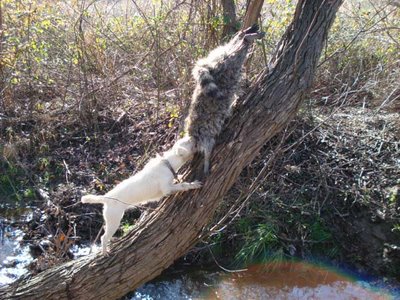
Pearl climbs a tree to grab a very dead raccoon. She got to work this one a little, as did Moxie.
